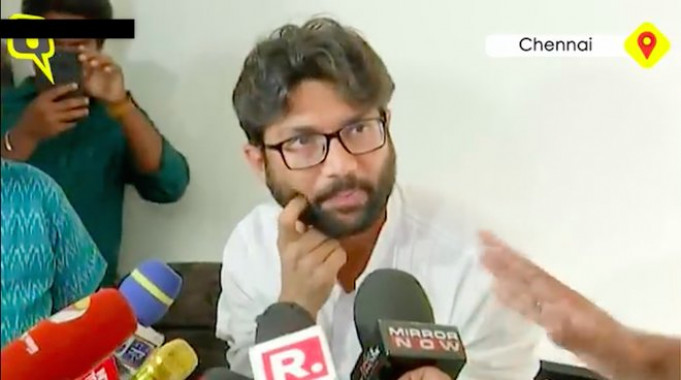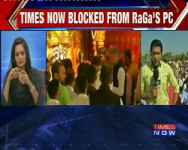Mevani and ‘that mic’
The youngest voices in our political firmament, Shehla Rashid and Jignesh Mevani, were subjected to much ‘alochana’ by media persons for refusing to engage with some media houses. The spontaneous media boycott of Mevani in Chennai, which wasn’t a boycott according to some, raised the important question about who does or does not have the right to refuse access to a media person and under what circumstances.
The Oxford Dictionary definition of ‘news hole’ says: Noun: The area of a newspaper or magazine that is available for news stories, after deduction of the area taken by adverts, pictures, etc.; (hence) the amount of airtime available in a news programme, channel, etc., for news broadcasting.
Considering the times we are living in and considering the now famous declaration by Citizen Jain, aka Vineet Jain, who heads that venerable institution called the Bennett Coleman and Company Limited (parent of Times of India, Times Now and Mirror Now) that "We are not in the newspaper business, we are in the advertising business”, we might safely assume that there are two kinds of self-perceptions afloat in the world of journalistic practice in India.
One kind that sees itself as a purveyor of information in public interest, which all of us by habit recognise as journalism. Those that practice this we say are journalists.
Then there are the other kind who on the explicit direction of their bosses are (in advertising business?) required to fill-in the news holes, after the advertising requirements, in letter, spirit and chequebook are fulfilled first. As Ken Auletta points out in his piece on Citizen Jain, “For a hefty fee, TheTimes of India will even change the name on its masthead … Rather than worry about editorial independence and the wall between the newsroom and the sales department, they propose that one secret to a thriving newspaper business lies in dismantling that wall.”
This profitable template has spawned some powerful clones in news television that are overtly and excessively loyal to their political sponsors, whose news holes are compromised and sold to benefit the piper who pays. Their own interests are THE national interest – non-negotiable.
So then, we have two categories of information disseminators: journalists and those who are fillers of newsholes (NHFs). And the NHFs are governed by what surrounds the news hole because the so-called wall has been torn down like the Berlin Wall.
In today’s polarised media world, we can clearly see the journalists who are putting their lives on the line to inform us on matters of public interest that can shape our collective future in this democracy; and the NHFs who have been solely exerting themselves to ensure the access of their masters to centres of power and profits.
But when we debate journalism, we often glibly claim the constitutionally extrapolated right to free speech that has been extended to the media as sacrosanct, and include both categories of media practice. Can a corporate entity that forages for favour where it will, sells its mast-head or peddles lies for a fee, still be a claimant to unfettered right to free speech that the Constitution of India bestows on the media, with reasonable restrictions?
In these perverse times, one gets to see fringe spokespersons sitting on prime time TV debates invoke the right to free speech while calling for assassinations and lynching. Does free speech cover the right to abet murder, spread rumours and to spread communal hatred?
In the absence of any coherent regulatory initiative, society is throwing up its own solutions. While coping with these perversions that fill the news holes, two kinds of public figures – be they politicians, film stars or sportspersons – seem to have emerged; those who seek the NHFs and those who are wary of them and sometimes shun them.
Often, the latter happen to be the victims of persistent fake news attacks on mainstream and social media like the JNU student leaders and newly emerging political voices like Mevani. Those who shun the NHFs resort to social media or to the few remaining journalists in the mainstream/legacy media space.
The refusal of Shehla Rashid and Jignesh Mevani to engage with some media houses gave rise to a stormy debate among journalists. Some Chennai media persons began to claim that they collectively boycotted Mevani’s press meeting through the tweet of a much-liked journalist, which was contextualised by a piece by Nityanand Jayaraman in thewire.in
There was also some debate about what constitutes censorship. Does the refusal of an individual politician to allow a particular channel in his or her media interaction constitute censorship? Or is it censorship only when the state agencies selectively deny access to individual media houses? Can elected representatives selectively refuse to engage with some media houses?
Some in the debate felt that individuals have a right to decide which media they engage with. Some others felt that no one can refuse a journalist who is seeking information. And then, when is a press interaction a press conference? Is it a press conference only when the organisations/individuals seeking the media’s attention invite the media? Or is any impromptu interaction with media also an event where the newsmakers cannot object to the presence of some media houses?
In the last decade or so, the emergence of 24x7 electronic news media has dehumanised the business of newsgathering, much to the despair of ordinary citizens. Media persons exercising their right to gather sound bytes from grievously injured people, and publicly fighting over first access to sources, perhaps are the most obvious of such instances.
Then during the Gujarat elections, some channels deliberately played the edited bites of Mani Shankar Aiyar . Some of the channels spew venom based on fake and manufactured videos against the JNU students, Mevani and Alpesh Thakor with damaging hashtags, dinning falsehoods into those who view them. Neither of these two instances are innocent mistakes by oversight.
The anchors in the safety of their studios may push their political or economic agendas, but the young men and women employed by them to gather news, who go out to cover events bear the consequences. They may see themselves as journalists. But the bosses see them as NHFs. More of them are reading the signs early and quitting. Those that stay on at least must have the self-awareness to understand that the public, and the newsmakers, don’t see them as journalists either, much like the bosses, but see them as the unscrupulous NHFs.
If one listens carefully to what Mevani said while refusing to participate in the impromptu news interaction, he said that he will not speak to the group if “that mic is there”. He did not object to the person who came with the mic. The mic represents the institution he does not want to deal with. Whatever the mic and the camera record will be used to distort and abuse. And he is unwilling to subject himself to it.
While the media employee is outraged about this ‘discrimination’, will he have the courage of conviction back in the newsroom to object to the gratuitous distortion of the information he has gathered? Is that kosher in exchange for a pay cheque? And why is everyone in public and private life obliged to play along? Because someone lays claim to being the ‘free press’? Is my right to safety and dignity of no consequence before this over-arching claim?
One would like to say to these media people, if the media house that employs them expects them to violate the personal dignity and the freedoms of others to exercise their own right to free speech, they do not deserve to be recognised as journalists, with all the dignity and privileges that go with the profession.
Every profession has some recognised rules of engagement. Before the 24x7 news channel boom began, the concern for free speech was about protecting the journalists in their work of ferreting out facts about the lapses in the judiciary, the legislature and the executive.
The media played a role in maintaining a balance between them. With the more powerful emergence of corporate influence over all branches of the government and the direct participation of both political and business entities in the media, a nexus of powerful players has emerged that is threatening to stifle public interest altogether.
Earlier, if a journalist wrote about corruption, s/he would have cause to worry about threats from the company that is written about. Today, we see that it is difficult to find takers for such stories among legacy media houses. But for online news portals like The Caravan (though still in print), thewire.in, scroll.in, many stories would not be in the public domain today.
To add insult to injury, the legacy media are not only silent about important issues of public interest, the backlash assault against such exercise of free speech by online media is likely to come from legacy media, driven by corporate outrage.
Many journalists have moved online and are breathing easy. The NHFs are still serving their masters well, hankering for that elusive respect that can only be earned through self-awareness and self-respect on their part. As someone commented, the people in public life have understood that the legacy media needs them more than they need the media for publicity.
Being NHFs is not worth it. Become journalists.
Padmaja Shaw is former professor of Communication and Journalism at Osmania University.








